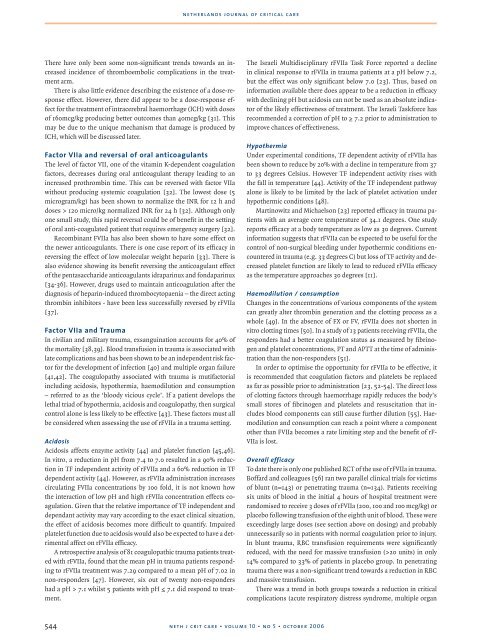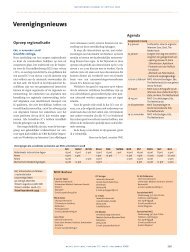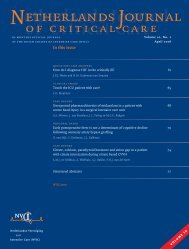Netherlands Journal
NJCC Volume 10, Oktober 2006
NJCC Volume 10, Oktober 2006
- No tags were found...
Create successful ePaper yourself
Turn your PDF publications into a flip-book with our unique Google optimized e-Paper software.
netherlands journal of critical care<br />
There have only been some non-significant trends towards an increased<br />
incidence of thromboembolic complications in the treatment<br />
arm.<br />
There is also little evidence describing the existence of a dose-response<br />
effect. However, there did appear to be a dose-response effect<br />
for the treatment of intracerebral haemorrhage (ICH) with doses<br />
of 160mcg/kg producing better outcomes than 40mcg/kg [31]. This<br />
may be due to the unique mechanism that damage is produced by<br />
ICH, which will be discussed later.<br />
Factor VIIa and reversal of oral anticoagulants<br />
The level of factor VII, one of the vitamin K-dependent coagulation<br />
factors, decreases during oral anticoagulant therapy leading to an<br />
increased prothrombin time. This can be reversed with factor VIIa<br />
without producing systemic coagulation [32]. The lowest dose (5<br />
microgram/kg) has been shown to normalize the INR for 12 h and<br />
doses > 120 micro/kg normalized INR for 24 h [32]. Although only<br />
one small study, this rapid reversal could be of benefit in the setting<br />
of oral anti-coagulated patient that requires emergency surgery [32].<br />
Recombinant FVIIa has also been shown to have some effect on<br />
the newer anticoagulants. There is one case report of its efficacy in<br />
reversing the effect of low molecular weight heparin [33]. There is<br />
also evidence showing its benefit reversing the anticoagulant effect<br />
of the pentasaccharide anticoagulants idraparinux and fondaparinux<br />
[34-36]. However, drugs used to maintain anticoagulation after the<br />
diagnosis of heparin-induced thrombocytopaenia – the direct acting<br />
thrombin inhibitors - have been less successfully reversed by rFVIIa<br />
[37].<br />
Factor VIIa and Trauma<br />
In civilian and military trauma, exsanguination accounts for 40% of<br />
the mortality [38,39]. Blood transfusion in trauma is associated with<br />
late complications and has been shown to be an independent risk factor<br />
for the development of infection [40] and multiple organ failure<br />
[41,42]. The coagulopathy associated with trauma is mutifactorial<br />
including acidosis, hypothermia, haemodilution and consumption<br />
– referred to as the ‘bloody vicious cycle’. If a patient develops the<br />
lethal triad of hypothermia, acidosis and coagulopathy, then surgical<br />
control alone is less likely to be effective [43]. These factors must all<br />
be considered when assessing the use of rFVIIa in a trauma setting.<br />
Acidosis<br />
Acidosis affects enzyme activity [44] and platelet function [45,46].<br />
In vitro, a reduction in pH from 7.4 to 7.0 resulted in a 90% reduction<br />
in TF independent activity of rFVIIa and a 60% reduction in TF<br />
dependent activity [44]. However, as rFVIIa administration increases<br />
circulating FVIIa concentrations by 100 fold, it is not known how<br />
the interaction of low pH and high rFVIIa concentration effects coagulation.<br />
Given that the relative importance of TF independent and<br />
dependant activity may vary according to the exact clinical situation,<br />
the effect of acidosis becomes more difficult to quantify. Impaired<br />
platelet function due to acidosis would also be expected to have a detrimental<br />
affect on rFVIIa efficacy.<br />
A retrospective analysis of 81 coagulopathic trauma patients treated<br />
with rFVIIa, found that the mean pH in trauma patients responding<br />
to rFVIIa treatment was 7.29 compared to a mean pH of 7.02 in<br />
non-responders [47]. However, six out of twenty non-responders<br />
had a pH > 7.1 whilst 5 patients with pH ≤ 7.1 did respond to treatment.<br />
The Israeli Multidisciplinary rFVIIa Task Force reported a decline<br />
in clinical response to rFVIIa in trauma patients at a pH below 7.2,<br />
but the effect was only significant below 7.0 [23]. Thus, based on<br />
information available there does appear to be a reduction in efficacy<br />
with declining pH but acidosis can not be used as an absolute indicator<br />
of the likely effectiveness of treatment. The Israeli Taskforce has<br />
recommended a correction of pH to ≥ 7.2 prior to administration to<br />
improve chances of effectiveness.<br />
Hypothermia<br />
Under experimental conditions, TF dependent activity of rFVIIa has<br />
been shown to reduce by 20% with a decline in temperature from 37<br />
to 33 degrees Celsius. However TF independent activity rises with<br />
the fall in temperature [44]. Activity of the TF independent pathway<br />
alone is likely to be limited by the lack of platelet activation under<br />
hypothermic conditions [48].<br />
Martinowitz and Michaelson [23] reported efficacy in trauma patients<br />
with an average core temperature of 34.1 degrees. One study<br />
reports efficacy at a body temperature as low as 30 degrees. Current<br />
information suggests that rFVIIa can be expected to be useful for the<br />
control of non-surgical bleeding under hypothermic conditions encountered<br />
in trauma (e.g. 33 degrees C) but loss of TF activity and decreased<br />
platelet function are likely to lead to reduced rFVIIa efficacy<br />
as the temperature approaches 30 degrees [11].<br />
Haemodilution / consumption<br />
Changes in the concentrations of various components of the system<br />
can greatly alter thrombin generation and the clotting process as a<br />
whole [49]. In the absence of FX or FV, rFVIIa does not shorten in<br />
vitro clotting times [50]. In a study of 13 patients receiving rFVIIa, the<br />
responders had a better coagulation status as measured by fibrinogen<br />
and platelet concentrations, PT and APTT at the time of administration<br />
than the non-responders [51].<br />
In order to optimise the opportunity for rFVIIa to be effective, it<br />
is recommended that coagulation factors and platelets be replaced<br />
as far as possible prior to administration [23, 52-54]. The direct loss<br />
of clotting factors through haemorrhage rapidly reduces the body’s<br />
small stores of fibrinogen and platelets and resuscitation that includes<br />
blood components can still cause further dilution [55]. Haemodilution<br />
and consumption can reach a point where a component<br />
other than FVIIa becomes a rate limiting step and the benefit of rF-<br />
VIIa is lost.<br />
Overall efficacy<br />
To date there is only one published RCT of the use of rFVIIa in trauma.<br />
Boffard and colleagues [56] ran two parallel clinical trials for victims<br />
of blunt (n=143) or penetrating trauma (n=134). Patients receiving<br />
six units of blood in the initial 4 hours of hospital treatment were<br />
randomised to receive 3 doses of rFVIIa (200, 100 and 100 mcg/kg) or<br />
placebo following transfusion of the eighth unit of blood. These were<br />
exceedingly large doses (see section above on dosing) and probably<br />
unnecessarily so in patients with normal coagulation prior to injury.<br />
In blunt trauma, RBC transfusion requirements were significantly<br />
reduced, with the need for massive transfusion (>20 units) in only<br />
14% compared to 33% of patients in placebo group. In penetrating<br />
trauma there was a non-significant trend towards a reduction in RBC<br />
and massive transfusion.<br />
There was a trend in both groups towards a reduction in critical<br />
complications (acute respiratory distress syndrome, multiple organ<br />
544<br />
neth j crit care • volume 10 • no 5 • october 2006







